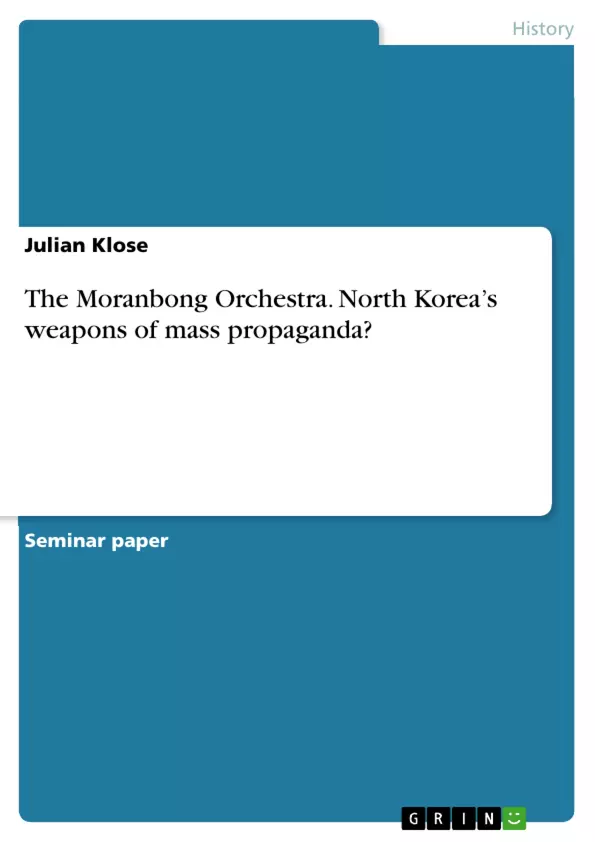The first appearances of the Moranbong orchestra raised hopes of more liberal policies under the then-new North Korean leader Kim Jong-un. Looking at Moranbong to start with seems therefore promising for numerous reasons. First, the band is a reminder that there is more in North Korea than nuclear weapons and a "little rocket man". It recognises North Koreans as human beings with a particular taste in music, fashion, and entertainment living within the barriers set by the political system. Since no political system is totally unresponsive to popular interest, research might indicate get an idea of "North Koreaness" under Kim Jong-un. Second, there is remarkably little research on 21st century North Korean music in general and Moranbong in particular. Existing research has explored either a cultural or a technical approach by examining the cultural motives, styles or performance techniques.
Building on these findings, this paper asks whether Moranbong could be another tool employed by Kim Jong-un to legitimate his regime. It is argued here that even a system like North Korea cannot exist repression alone but needs to build a certain degree of support by the population, i.e. legitimacy. It is argued here that Moranbong serves both functions by providing a veritable propaganda tool to the North Korean regime. This tool can be directed at both the domestic and foreign audiences by implementing associations and symbols recognized by the respective audiences. Pyongyang can adjust this tool to serve the expectations of the respective audiences. This means neither a cultural liberalization nor "putting old revolutionary wine into new aesthetic forms". but a new style of North Korean music in the 21st century.
The argument is examined as a historical case study drawing on North Korean primary and secondary sources. The methods and challenges of the methodology are further explained in the next chapter as well as the theoretical framework of legitimation and propaganda. The third chapter offers a discussion of the contested concepts. The fourth chapter illustrates the theoretical argument in an empirical analysis. Particular attention is paid to the performance style, the content and the international context of the Moranbong performances. Chapter five sums up the analysis, discusses its limitations and outlines possibilities for further research.
Inhaltsverzeichnis
- INTRODUCTION
- THEORETICAL FRAMEWORK AND METHODOLOGY
- THEORY - LEGITIMATION THROUGH PROPAGANDA
- CASE SELECTION
- METHODOLOGY AND SOURCES
- THE MORANBONG ORCHESTRA
- MEANS OF DISTRIBUTION
- MUSIC AND LYRICS
- VISUAL APPEARANCE
- NATIONAL AND INTERNATIONAL CONTEXT
- CONCLUSION
Zielsetzung und Themenschwerpunkte
This term paper explores the Moranbong Orchestra, a North Korean all-female orchestra, and analyzes its potential as a propaganda tool for Kim Jong-un's regime. It examines how the band utilizes music, visuals, and performance styles to garner support and legitimize the regime both domestically and internationally.
- The role of propaganda in legitimizing authoritarian regimes
- The use of music and entertainment as a form of propaganda
- The cultural and political context of North Korea
- The Moranbong Orchestra as a case study in North Korean propaganda
- The impact of the Moranbong Orchestra on domestic and international audiences
Zusammenfassung der Kapitel
- Introduction: This chapter introduces the Moranbong Orchestra and its emergence in 2012, highlighting its unique characteristics and the potential for greater liberalization in North Korea. It argues that the orchestra offers insights into North Korean society under Kim Jong-un and emphasizes the limited research on 21st century North Korean music.
- Theoretical Framework and Methodology: This chapter outlines the theoretical framework of legitimation and propaganda, emphasizing how authoritarian regimes use propaganda to achieve their goals. It also discusses the selection of the Moranbong Orchestra as a case study and addresses the challenges of working with North Korean sources.
Schlüsselwörter
Key terms and concepts include: North Korea, Kim Jong-un, propaganda, legitimation, Moranbong Orchestra, music, performance, visual appearance, cultural diplomacy, authoritarianism, regime stability, domestic and international audiences.
- Arbeit zitieren
- Julian Klose (Autor:in), 2019, The Moranbong Orchestra. North Korea’s weapons of mass propaganda?, München, GRIN Verlag, https://www.hausarbeiten.de/document/537915


